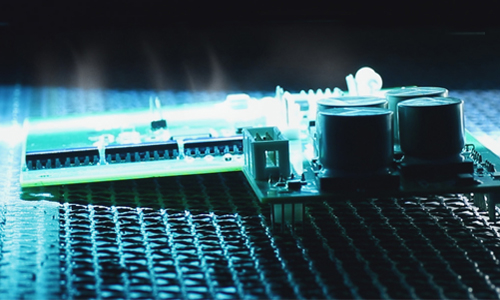¿Qué es la desgasificación de materiales curables por luz?
Si se emite un vapor gaseoso del adhesivo o recubrimiento de su pieza durante el proceso de curado con luz o cuando se expone a condiciones extremas después del curado, es probable que esté observando el fenómeno llamado desgasificación o liberación de gases.
Cuando se produce una polimerización o una reacción química muy rápida, la química expuesta a la energía de la luz, el calor o el vacío puede liberar una pequeña cantidad de gas que quedó atrapado, absorbido, disuelto o congelado antes de que el material se curara por completo. La humedad inherente a las materias primas suele constituir la mayor parte de los compuestos desgasificados. También puede haber niveles de ppm de impurezas de las materias primas o trazas de monómeros sin reaccionar. El resultado de esta desgasificación puede ser una pérdida de peso involuntaria o la deposición de material sobre las superficies, lo que podría interferir con el funcionamiento adecuado de los componentes terminados.
Pruebas materiales curables con luz La desgasificación es fundamental por muchas razones, la más obvia es la posible contaminación del entorno de uso final en el que se puede utilizar una determinada pieza.
La desgasificación o deposición de vapor también puede ser preocupante por cualquiera de las siguientes razones:
- Indicación de descomposición o cambio en la estructura de un sustrato, recubrimiento o adhesivo.
- Contaminación de superficies que deben permanecer limpias para conservar sus propiedades eléctricas
- Advertencia de posible corrosión, agrietamiento de plásticos u otros mecanismos de debilitamiento de la superficie.
Una prueba de desgasificación ampliamente utilizada es la ASTM E595, a veces denominada Especificación de baja desgasificación de la NASA. Los fabricantes suelen exigirla para especificar un adhesivo o recubrimiento para su proceso, como en el montaje de placas de circuitos impresos para aplicaciones ópticas, electrónicas y aeroespaciales/defensivas.
La prueba ASTM E595 se realiza a 125 °C (257 °F) bajo un vacío de 5 X 10-5 Torr durante 24 horas. Se miden la pérdida de masa total (TML %) y el material volátil condensable recolectado (CVCM %). También se informa la recuperación de vapor de agua (WVR %).
El TML es el porcentaje de pérdida de peso de la muestra durante la prueba y debe ser <1,00 % para cumplir con la especificación. El CVCM es el porcentaje de compuestos desgasificados de una muestra que se condensa en un colector durante la prueba con un umbral de <0,10 %. El WVR no se utiliza normalmente como criterio de aprobación o rechazo para la norma ASTM E595, pero puede ayudar a demostrar qué porcentaje del TML se puede atribuir al vapor de agua.
En el caso de aplicaciones de aviónica u optoelectrónicas, el CVCM es el más crítico, ya que podría indicar que se está depositando material sobre piezas ópticas en áreas no previstas, o que las piezas podrían empañarse o incluso perder la continuidad eléctrica. En condiciones de temperatura ambiente, una ventilación o circulación de aire adecuadas cerca de la operación de curado ayudarán a mitigar la redeposición de desgasificación sobre las piezas, pero esto es un desafío mayor en condiciones de vacío.
Las pruebas de desgasificación pueden ser un paso crucial para garantizar a los fabricantes que sus componentes terminados cumplen con estándares críticos y ayudan a reducir la posibilidad de fallas de las piezas.

